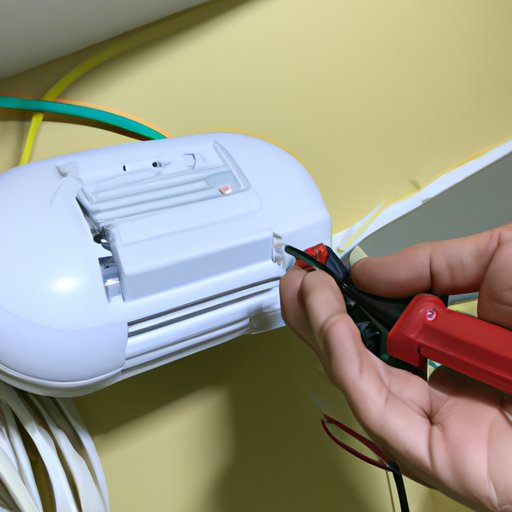Introduction
When it comes to electrical wiring, safety is of utmost importance. Knowing the correct size wire for an electric dryer is an important factor in ensuring safe installation. In this article, we will explore what size wire for electric dryer is needed, as well as provide a step-by-step guide for choosing and installing the right type of wire.
Definition of Dryer Electrical Wiring
Dryer electrical wiring refers to the type and size of wires that are used to connect an electric dryer to the home’s power supply. The wires are typically made from copper or aluminum, and come in a variety of sizes and gauges. The size of the wire used for a particular dryer depends on several factors, including the type of dryer, the voltage requirements, and the length of the run.
Overview of Different Sizes and Types of Wiring
When it comes to electrical wiring, there are three main types: THHN (Thermoplastic High Heat-Resistant Nylon), Romex, and UF (Underground Feeder). THHN is a single-conductor wire that is commonly used in residential settings, while Romex is a multi-conductor cable that is typically used for running power from one point to another. UF wiring is designed specifically for outdoor use and is usually buried underground. Each type of wire has various sizes, ranging from 10 AWG (American Wire Gauge) to 2 AWG, with larger numbers representing smaller wire diameters.
What You Need to Know About Wire Gauge for Electric Dryers
When selecting the right size wire for an electric dryer, it is important to understand wire gauge. Wire gauge is a measure of the diameter of the wire, which determines its current-carrying capacity. As a general rule, the thicker the wire, the higher the amperage rating, and the greater the load it can handle. For example, a 10 AWG wire is able to carry up to 30 amps of current, while a 6 AWG wire can carry up to 60 amps of current.

Factors to Consider When Selecting the Right Wire Gauge
In addition to understanding wire gauge, there are other factors to consider when selecting the right size wire for an electric dryer. These include the type of dryer, the voltage requirements, and the length of the run. The type of dryer will determine the amount of current it draws, which in turn dictates the size of the wire needed. The voltage requirements will dictate the minimum size of the wire, while the length of the run will influence the gauge of the wire. For example, a longer run may require a thicker wire in order to maintain the same level of current.

How to Choose the Right Size Wire for Your Electric Dryer
When selecting the right size wire for an electric dryer, it is important to follow the manufacturer’s specifications. The manual will typically provide a recommended wire size and gauge. If the manual does not provide a recommendation, then the following steps can be taken to choose the right size wire:
Step-by-Step Guide to Choosing the Right Wire
- Determine the type of dryer and the current it draws.
- Calculate the length of the wiring run.
- Check the voltage requirements.
- Select a wire size based on the current draw, length of the run, and voltage requirements.
- Ensure the wire is rated for the type of dryer.
Benefits of Using the Proper Wire
Using the proper size wire for an electric dryer is essential for safety and performance. The right size wire ensures the dryer draws the correct amount of current, and prevents overheating and fire hazards. It also helps reduce energy consumption, allowing the dryer to run more efficiently and saving money on electricity bills.

Tips for Installing the Right Type and Size of Wire for an Electric Dryer
Once the right size wire has been selected, it is important to ensure it is properly installed. Here are some tips for installing the right type and size of wire for an electric dryer:

Guidelines for Installing the Right Wire
- Use only approved wiring materials.
- Follow local building codes and regulations.
- Make sure all connections are tight and secure.
- Use properly sized circuit breakers and fuses.
- Label all wires and connections.
Common Mistakes to Avoid
- Using the wrong type of wire.
- Using the wrong size of wire.
- Making incorrect connections.
- Not labeling wires and connections.
- Not using properly sized circuit breakers and fuses.
Conclusion
Choosing the right size wire for an electric dryer is essential for safety and performance. By understanding wire gauge, taking into account the type of dryer, voltage requirements, and length of the run, and following the manufacturer’s specifications, you can select the right size wire for your dryer. Installing the right type and size of wire is also critical; follow the guidelines outlined above and avoid common mistakes to ensure safe and efficient operation of your dryer.
Summary of Main Points
This article explored what size wire for electric dryer is needed, as well as provided a step-by-step guide for choosing and installing the right type of wire. It discussed different types and sizes of wiring, factors to consider when selecting the right wire gauge, and tips for proper installation. Finally, it offered a reminder of the benefits of proper wiring selection.
Final Reminder of Benefits of Proper Wiring Selection
Properly selecting and installing the right size wire for an electric dryer is essential for safety and performance. Doing so prevents overheating, fire hazards, and energy waste, while also helping to save money on electricity bills.


